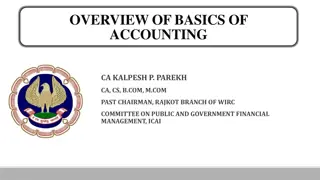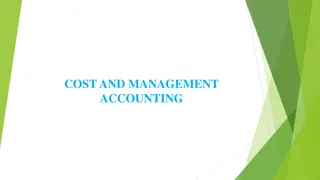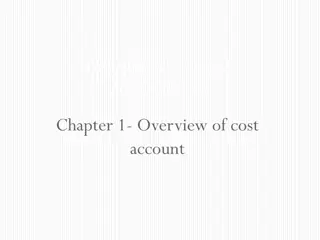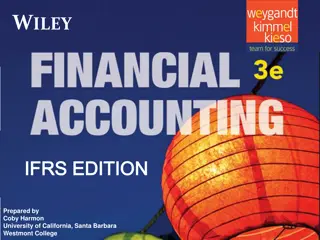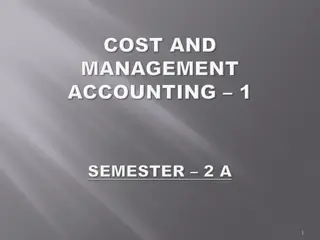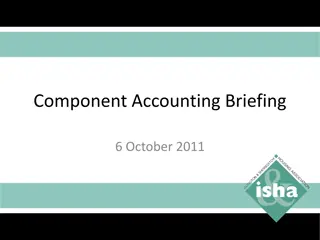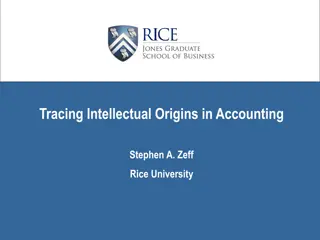Basic Concepts of Accounting
Accounting is the process of identifying, measuring, and communicating information to enable informed judgments and decisions by users. It involves transactions, financial statements, principles, and concepts like business entity, money measurement, and going concern. Accounting conventions include conservatism, disclosure, materiality, and consistency.
Download Presentation

Please find below an Image/Link to download the presentation.
The content on the website is provided AS IS for your information and personal use only. It may not be sold, licensed, or shared on other websites without obtaining consent from the author.If you encounter any issues during the download, it is possible that the publisher has removed the file from their server.
You are allowed to download the files provided on this website for personal or commercial use, subject to the condition that they are used lawfully. All files are the property of their respective owners.
The content on the website is provided AS IS for your information and personal use only. It may not be sold, licensed, or shared on other websites without obtaining consent from the author.
E N D
Presentation Transcript
BASIC CONCEPT OF ACCOUNTING
INTRODUCTION Accounting is the process of identifying, measuring and communicating information to permit informed judgments and decisions by users of the information. Accounting not only transactions and conveys position of a business enterprise; it also analyses and reports the information in documents called financial statements. economic records financial financial the
ACCOUNTING PRINCIPLES Accounting principles are based on certain concepts, convention, and tradition have been evolved by accounting regulators and are followed internationally. The rules for accounting transactions and statements, are known as the Generally Accepted Accounting Principles, or GAAP. Accounting principles involve both accounting concepts and accounting conventions. authorities and for financial financial preparing
ACCOUNTING CONCEPTS Business entity concept: A business and its owner should be treated separately as far as their financial transactions are concerned. Money measurement concept: Only business transactions that can be expressed in terms of money are recorded records of other types of transactions may be kept separately. Dual aspect concept: corresponding debit is made. The recording of a transaction is complete only with this dual aspect. in accounting, though For every credit, a
Going business is expected to continue for a fairly long time and carry out obligations. This assumes that the business will not be forced to stop functioning and liquidate its assets at fire-sale prices. Cost concept: The fixed assets of a business are recorded on the basis of their original cost in the first year of accounting. Subsequently, these assets are recorded minus depreciation. No rise or fall in market price is taken into account. The concept applies only to fixed assets. concern concept: In accounting, a its commitments and
Accounting year concept: Each business chooses a specific time period to complete a cycle of the accounting process for quarterly, or annually as per a fiscal or a calendar year. Matching concept: This principle dictates that for every entry of revenue recorded in a given accounting period, an equal expense entry has to be recorded for correctly calculating profit or loss in a given period. Realisation concept: According to this concept, profit is recognised only when it is earned. An advance or fee paid is not considered a profit until the goods or services have been delivered to the buyer. example, monthly,
ACCOUNTING CONVENTIONS There are four main conventions in practice in accounting: conservatism; disclosure; and materiality. consistency; full Conservatism is the convention by which, when two values of a transaction are available, the lower-value transaction convention, profit should never be overestimated, and there should always be a provision for losses. is recorded. By this Consistency accounting principles from one period of an accounting cycle to the next, so that the same standards are applied to calculate profit and loss. prescribes the use of the same
Materiality should be recorded in accounting. Accountants should record important data and leave out insignificant information. means that all material facts Full disclosure entails the revelation of all information, both favourable and detrimental to a business enterprise, and which are of material value to creditors and debtors.
BASIC ACCOUNTING TERMS Accounting equation: The accounting equation, the basis for the double-entry system, is written as follows: Assets = Liabilities + Stakeholders equity Accounting methods: between two methods cash accrual accounting. Under cash basis accounting, preferred by small businesses, all revenues and expenditures at the time when payments are actually received or sent are recorded. Under accrual basis accounting, income is recorded when earned and expenses are recorded when incurred. Companies choose accounting or
Balance sheet: A financial report that provides a gist of a company s assets and liabilities and owner s equity at a given time. Capital: A financial asset and its value, such as cash and goods. Working capital is current assets minus current liabilities. Credit and debit: A credit is an accounting entry that either increases a liability or equity account, or decreases an asset or expense account. It is entered on the right in an accounting entry. A debit is an accounting entry that either increases an asset or expense account, or decreases a liability or equity account. It is entered on the left in an accounting entry.
Double-entry bookkeeping: Under double- entry bookkeeping, recorded in at least two accounts as a credit in one account and as a debit in another. Single-entry bookkeeping: Under the single- entry bookkeeping, mainly used by small or businesses, incomes recorded through summaries of cash disbursements. every transaction is and daily expenses and receipts are monthly and
Financial statement: A financial statement is a document that reveals the financial transactions of a business or a person. The three most statements for businesses are the balance sheet, cash flow statement, and profit and loss statement. important financial
BASIC ACCOUNTING PROCEDURES OR ANALYSIS OF BUSINESS PERFORMANCE In order to manage a business effectively from the financial perspective, important to measure: Asset structure of the business Profitability of the business How much profit is being generated iii. Analysis of cash flows When the cash is coming in, and iv. How it is being spent. it is always i. ii.
Accounting measurement of these processes to reflect what has happened to a business over a relevant period of time. The asset structure (solvency of business) is measured by the Balance Sheet, whilst the profit and cash pieces are measured by the Income Statement / Profit and Loss Account (liquidity of business) and the Cash Flow Statement respectively. is nothing more than the
THE INCOME STATEMENT / PROFIT AND LOSS ACCOUNT The income statement / profit and loss account measures the sales made and the costs incurred in a business over a particular time period. For external reporting this is usually for a year but internally most businesses will prepare their income statement / profit and loss account on a monthly or quarterly basis. The income statement / profit and loss account captures a sale when the product or service is delivered to the customer. Cash may or may not change hands at this stage.
Costs are recorded in the income statement / profit and loss account to reflect the costs of making the sales during that time period. All costs incurred in running a business are included in a income statement. But capital investment are not included. However, depreciation and other fixed costs are included. This is called the matching or accruals concept. This concept states that the costs recorded must match to the sales made in the relevant time period. Although the jargon in an income statement / profit and loss account may vary (especially from country to country) the costs are always deducted from sales in order of how closely they relate to the sale itself. The order that cost deduction appears is therefore: Cost of product sold Sales, general and administration costs Interest expense Tax expense After costs are deducted from sales, we are left with the bottom line profit (also known as the net income or profit after tax) which belongs consequently is reflected as part of shareholders equity on the balance sheet. to the shareholders, and

 undefined
undefined






